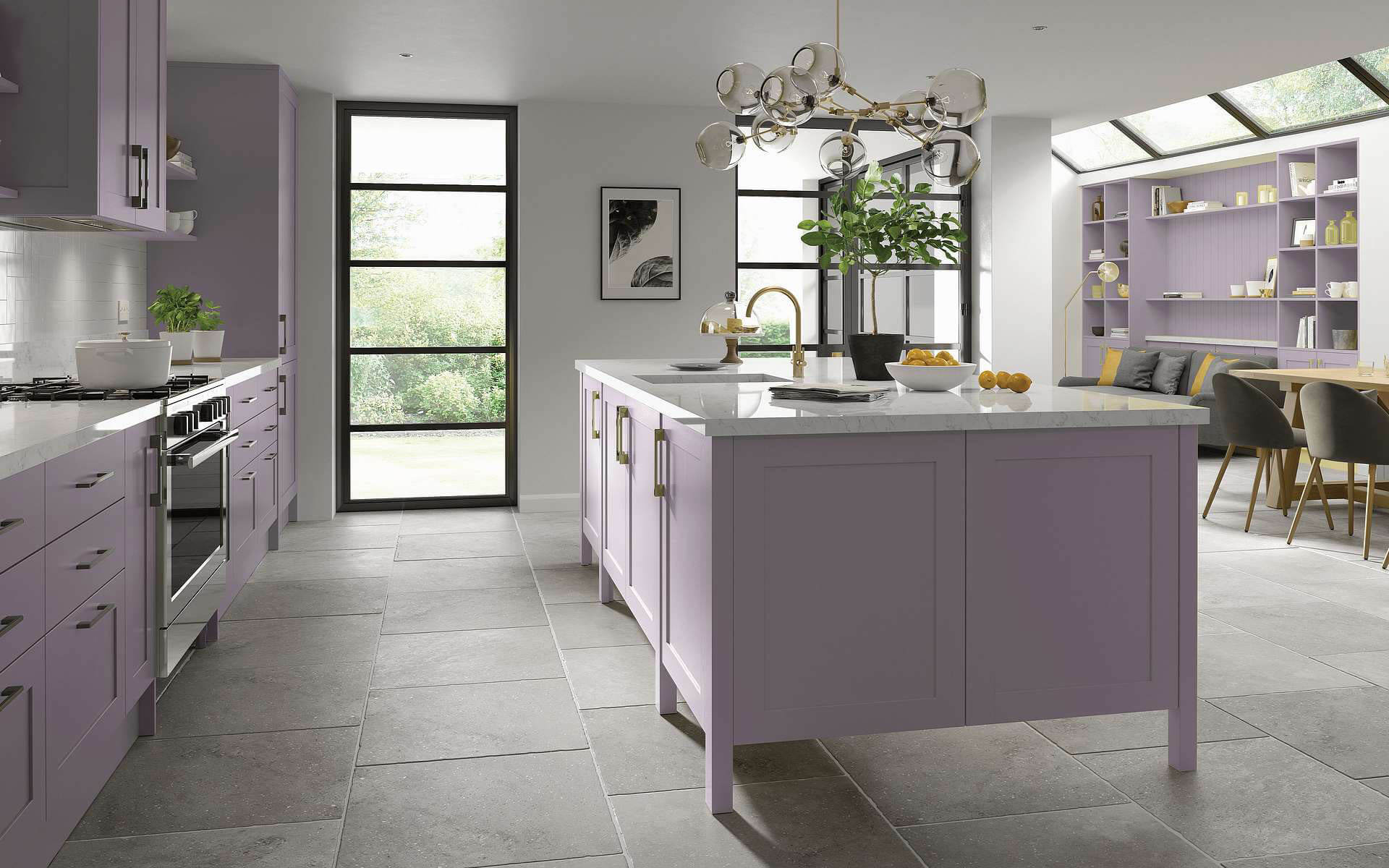Part 2: How to Design a Kitchen - Practical Design Elements
A great kitchen design is all about the details.
Welcome back! In Part 1, we discussed the first steps in designing your ideal kitchen, covering layouts, colours, and aesthetics suited to your personal needs. In Part 2, we'll look at the key practical elements needed to bring your vision to life.
In this phase, you'll be making crucial choices that will shape your kitchen. We'll offer guidance on things like taking accurate measurements, selecting the right appliances, and maximising storage and functionality, all without sacrificing style.
The kitchen is more than just a well-designed space; it's a practical area for work. Every choice you make, from the height of your countertops to the materials you use, is crucial. This is how you create a kitchen that's both useful and visually pleasing.
Now, take your measuring tape and notepad, and let's explore the practical aspects that will make your kitchen beautifully designed and highly functional.
Detailed Measurements and Proportions
Getting the measurements and proportions right is crucial in kitchen design. It helps create a space that's attractive and practical. Accurate dimensions ensure your kitchen not only looks good but is also comfortable for everyday use, making every task easier with well-planned spaces.
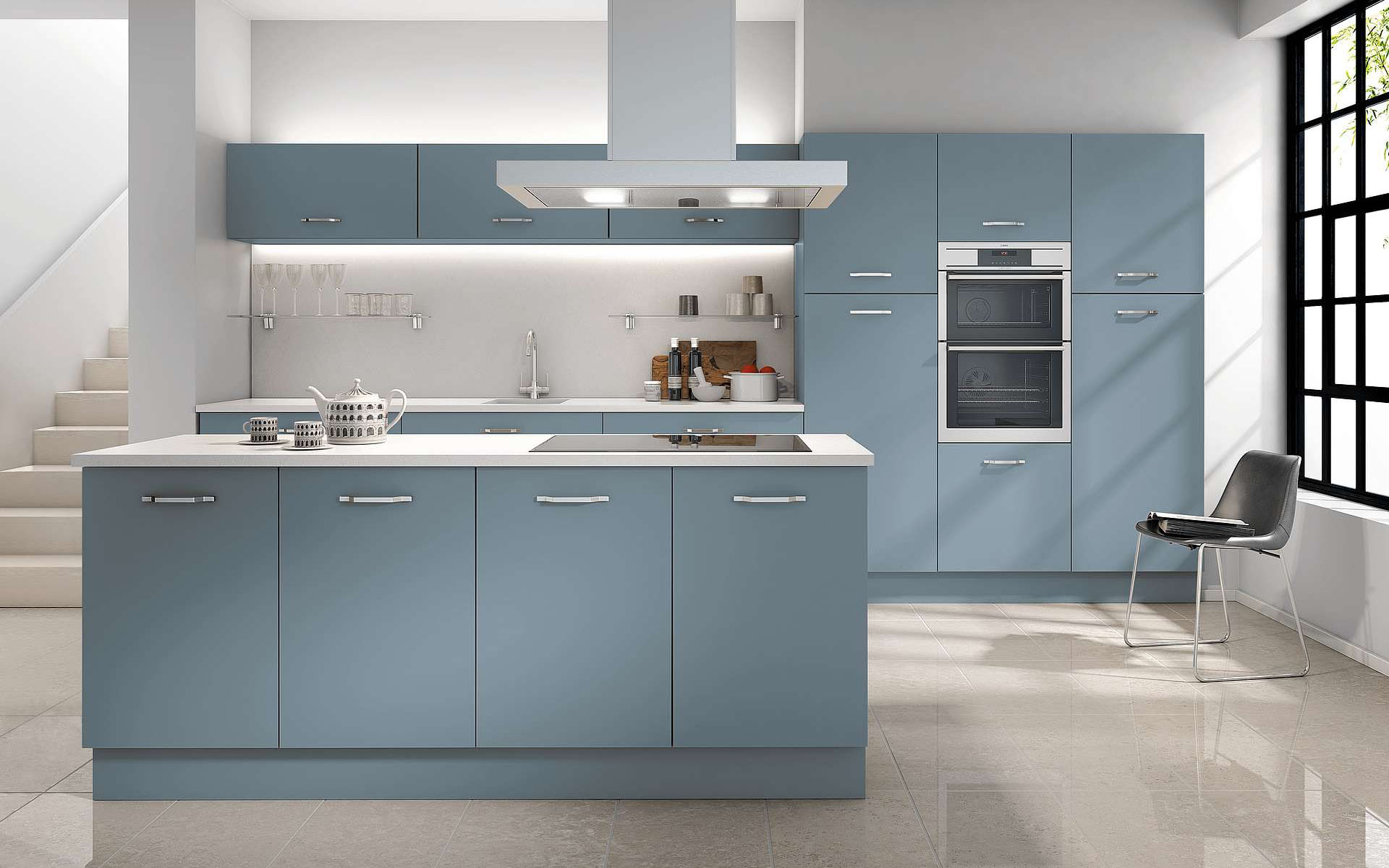
Importance of Accurate Measurements
Accurate Measurements in a kitchen design are not just important; they are fundamental. The success of your aesthetically pleasing, functionally efficient kitchen relies heavily upon them.
Measuring Your Space:
-
First, make a detailed kitchen map. Note the room's width, length, window and door locations, as well as any constant fixtures such as pipes or radiators. Don't forget to measure the height from floor to ceiling as it influences your choice of wall cabinets and extractor systems.
-
During your kitchen layout planning, think about any special architectural aspects like exposed beams, sloping ceilings, or recessed walls. These features can greatly impact your design decisions, from where to install cabinets to lighting choices. So, it's important to carefully consider and include these features in your overall design strategy. This helps make sure they improve both the usefulness and look of your kitchen, instead of being problems.
-
These figures are key for organising the layout and making sure everything from cupboards to appliances fits just right.
Appliance Sizes and Cabinetry Dimensions:
-
Choosing kitchen appliances needs careful attention, particularly to their full sizes, even when doors or drawers are open. This is important for avoiding any blockages, and making movement easy in the kitchen. When you think about these things, you increase the smoothness and usefulness of your kitchen overall.
-
It's important to make sure your cabinets fit your kitchen measurements, especially in unusual spaces or layouts. This might require innovative solutions like custom-made kitchen cabinets designed for specific corners or angled areas. Choosing made-to-measure cabinets can maximise storage and keep the design balanced and visually pleasing, both of which are essential for a practical and attractive kitchen.
Ergonomic Design:
Ergonomic Design in the kitchen means creating a space that fits with the user's needs. It's about planning where appliances and counters go, thinking about the best heights and distances, and making sure everything flows well. This makes cooking more enjoyable, less physically demanding, and the kitchen more practical to use every day.
Tailoring for Comfort and Efficiency:
-
The secret to an ergonomic kitchen is to design it with the users in mind. If you're significantly tall or short, think about changing the height of your countertops and where you place your appliances to prevent discomfort.
-
Plan your kitchen by arranging your oven, sink, and fridge wisely. This will form a practical work triangle, making usual tasks such as cooking, cleaning, and storing food easier and quicker by reducing unnecessary movements.
Optimising Heights and Distances:
-
Typically, kitchen counters are about 90 cm high. However, adjusting them to fit your height can make your kitchen much more comfortable to use. If you're shorter or have kids, lower counters may be better. For taller people, raised counters can avoid unnecessary bending and help prevent back pain. Adjusting your kitchen to fit everyone's needs makes it both practical and comfortable.
-
It's vital to make sure you have enough seating space, especially if your kitchen has a central island or breakfast bar. You should think about the number of seats, the space needed for comfortable legroom and the right height for chairs or stools. Proper spacing ensures easy movement and a comfortable seating experience, making communal kitchen areas more functional and enjoyable. Good planning here ensures your kitchen is a social, welcoming and comfortable place for everyone to gather and interact.
-
Think about adding an extra 30 cm of countertop space on each side of your hob or sink. This extra area is very useful in the kitchen, providing a handy spot for groceries, hot dishes from the oven, or prepared food items. These added spaces not only improve your kitchen's usefulness, but also make it safer by reducing clutter and lowering the risk of accidents.
Planning measurements and proportions thoroughly is key to designing a kitchen that is both practical and attractive. This attention to detail allows you to create a kitchen tailored to your everyday lifestyle, making kitchen tasks comfortable and efficient.
Read Kitchen Breakfast Bar Height, Stool & Counter Heights & Dimensions
Detailed Measurements and Proportions
Getting the measurements and proportions right is crucial in kitchen design. It helps create a space that's attractive and practical. Accurate dimensions ensure your kitchen not only looks good but is also comfortable for everyday use, making every task easier with well-planned spaces.
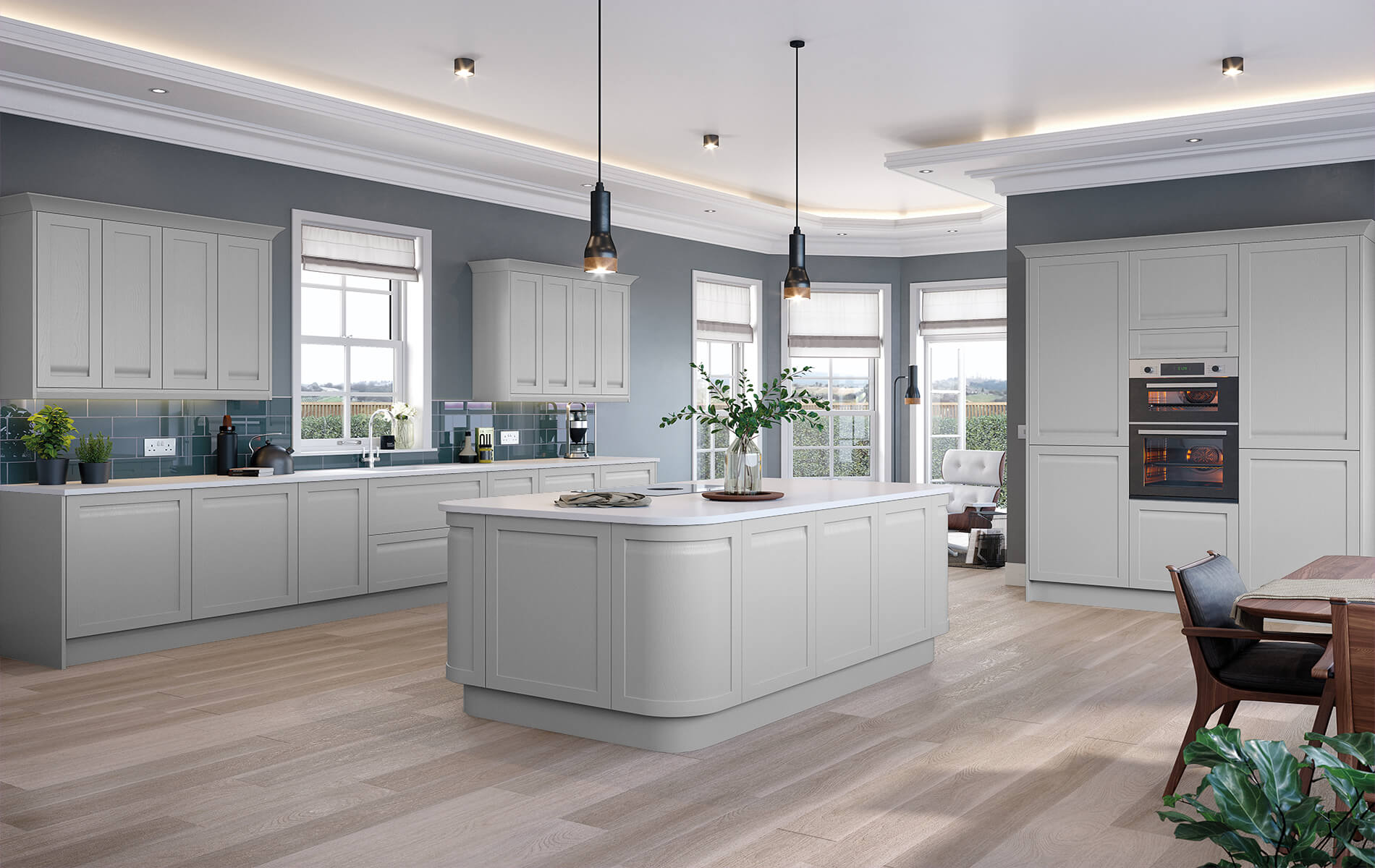
Importance of Accurate Measurements
Accurate Measurements in a kitchen design are not just important; they are fundamental. The success of your aesthetically pleasing, functionally efficient kitchen relies heavily upon them.
Measuring Your Space:
-
First, make a detailed kitchen map. Note the room's width, length, window and door locations, as well as any constant fixtures such as pipes or radiators. Don't forget to measure the height from floor to ceiling as it influences your choice of wall cabinets and extractor systems.
-
During your kitchen layout planning, think about any special architectural aspects like exposed beams, sloping ceilings, or recessed walls. These features can greatly impact your design decisions, from where to install cabinets to lighting choices. So, it's important to carefully consider and include these features in your overall design strategy. This helps make sure they improve both the usefulness and look of your kitchen, instead of being problems.
-
These figures are key for organising the layout and making sure everything from cupboards to appliances fits just right.
Appliance Sizes and Cabinetry Dimensions:
-
Choosing kitchen appliances needs careful attention, particularly to their full sizes, even when doors or drawers are open. This is important for avoiding any blockages, and making movement easy in the kitchen. When you think about these things, you increase the smoothness and usefulness of your kitchen overall.
-
It's important to make sure your cabinets fit your kitchen measurements, especially in unusual spaces or layouts. This might require innovative solutions like custom-made cabinets designed for specific corners or angled areas. Choosing made-to-measure cabinets can maximise storage and keep the design balanced and visually pleasing, both of which are essential for a practical and attractive kitchen.
Ergonomic Design:
Ergonomic Design in the kitchen means creating a space that fits with the user's needs. It's about planning where appliances and counters go, thinking about the best heights and distances, and making sure everything flows well. This makes cooking more enjoyable, less physically demanding, and the kitchen more practical to use every day.
Tailoring for Comfort and Efficiency:
-
The secret to an ergonomic kitchen is to design it with the users in mind. If you're significantly tall or short, think about changing the height of your countertops and where you place your appliances to prevent discomfort.
-
Plan your kitchen by arranging your oven, sink, and fridge wisely. This will form a practical work triangle, making usual tasks such as cooking, cleaning, and storing food easier and quicker by reducing unnecessary movements.
Optimising Heights and Distances:
-
Typically, kitchen counters are about 90 cm high. However, adjusting them to fit your height can make your kitchen much more comfortable to use. If you're shorter or have kids, lower counters may be better. For taller people, raised counters can avoid unnecessary bending and help prevent back pain. Adjusting your kitchen to fit everyone's needs makes it both practical and comfortable.
-
It's vital to make sure you have enough seating space, especially if your kitchen has a central island or breakfast bar. You should think about the number of seats, the space needed for comfortable legroom and the right height for chairs or stools. Proper spacing ensures easy movement and a comfortable seating experience, making communal kitchen areas more functional and enjoyable. Good planning here ensures your kitchen is a social, welcoming and comfortable place for everyone to gather and interact.
-
Think about adding an extra 30 cm of countertop space on each side of your hob or sink. This extra area is very useful in the kitchen, providing a handy spot for groceries, hot dishes from the oven, or prepared food items. These added spaces not only improve your kitchen's usefulness, but also make it safer by reducing clutter and lowering the risk of accidents.
Planning measurements and proportions thoroughly is key to designing a kitchen that is both practical and attractive. This attention to detail allows you to create a kitchen tailored to your everyday lifestyle, making kitchen tasks comfortable and efficient.
Selecting Appliances and Features
Selecting kitchen appliances involves more than just their appearance. You need to balance their practicality, size, energy efficiency, and how they fit into your kitchen design. This part will help you pick appliances that fulfil your needs and also boost your kitchen's look.
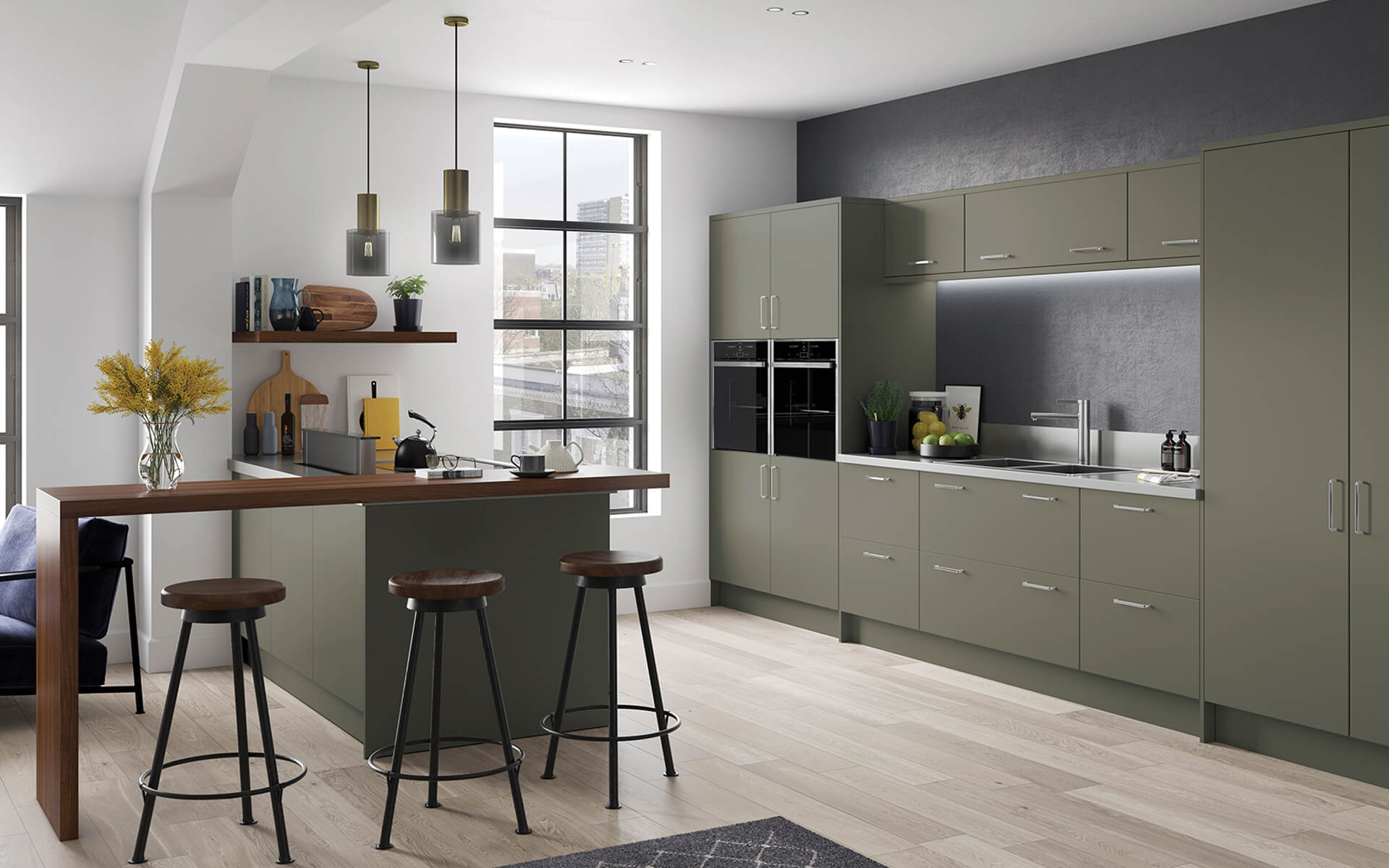
Choosing the Right Appliances:
Picking the right appliances is important for both looks and practicality in your kitchen. They should match your design and help with your cooking and daily needs.
Balancing Functionality, Size, and Style:
-
Start with Needs: Consider what your appliances need to do. Do you need a high-end stove, or will a typical one do? Is a large fridge required for family meals, or will a smaller one serve your needs?
-
Size Matters: It's important to think about the size of your kitchen appliances. You need to make sure they fit well in your kitchen and don't take up too much space. This way, your kitchen stays tidy and easy to use. Plus, you make the most out of all the space you've got.
-
Style and Aesthetics: When it comes to style, it's important to choose appliances that fit well with your kitchen's design. Whether you have a modern kitchen or a traditional kitchen, your appliances should blend in perfectly. This will not only enhance your kitchen's look but also create a well-coordinated space.
Energy Efficiency and Technological Features:
-
Green Options: When choosing kitchen appliances, try to pick energy-efficient models. They can help lower your electricity bills and are better for the environment. Look for features like energy-saving modes in fridges and ovens, or water-efficient dishwashers that still clean effectively. By doing this, you can save money and do your bit for the planet at the same time.
-
Using Modern Technology: Nowadays, smart appliances are a common feature in kitchen designs. They offer cool features like remote control with your phone, voice command, and personalised settings. This makes your kitchen work easier and turns cooking into a high-tech experience. More importantly, it makes your daily tasks more efficient and customised to fit your needs.
Integrating Appliances into Design
Integrating Appliances into Design is a key aspect of modern kitchen planning, ensuring that each appliance not only functions efficiently but also seamlessly blends into the overall aesthetic and layout of the space.
Built-in vs Freestanding Options:
-
Built-In for a Smooth Look: If you're seeking a neat and linear design for your kitchen, consider integrating built-in appliances like ovens, dishwashers, and refrigerators. These seamlessly blend with your cabinets, allowing for a sleek outcome. Besides improving your kitchen's overall look, this approach also introduces a modern touch. The appliances seem more like a natural part of your cabinets instead of standalone items.
-
Freestanding for Flexibility: Freestanding appliances are a great choice for your kitchen, thanks to their easy installation and replacement. They are practical and can add a unique flair to your kitchen's design. With various styles available, freestanding appliances can easily match your kitchen's aesthetics while providing convenience and functionality.
Creating a Cohesive Look with Appliances:
-
Matching Appliances with Cabinetry: It's crucial to choose appliances that match your cabinets and kitchen's overall colour scheme. For example, stainless steel appliances provide a modern, sleek look that pairs well with many cabinet styles and colours. This balance between appliances and kitchen design creates a unified and visually pleasing space where all elements work together seamlessly.
-
Consistent Aesthetic: Try to keep the style and look of your kitchen appliances the same. For example, if you pick a fridge in brushed steel finish, ideally choose a dishwasher and oven in a similar finish too. This brings a well-organised and sophisticated look to your kitchen, making everything blend well and look polished.
Pick kitchen appliances with features that suit your needs and blend well with your kitchen's design. This ensures they improve how your kitchen works and looks.
Kitchen Storage and Organization
Good storage solutions are key to a well-organised kitchen. They help keep your kitchen neat and practical, regardless of its size. In this section, we explore how to make the most out of your storage space with unique ideas and bespoke solutions that fit your specific needs.

Maximising Storage Space:
Maximising your kitchen storage helps keep the area tidy and practical, while also looking good and working well.
Innovative Solutions for Every Kitchen:
-
Flexible Storage for All Sizes: Smart storage solutions are crucial for all kitchens, no matter their size. Good storage can make even a small kitchen efficient and well-organised. In larger kitchens, it ensures everything has its place and is easy to find. Proper storage doesn't just improve your kitchen's functionality; it also makes cooking a more enjoyable experience. Here are some storage ideas to think about:
-
Corner Pull-Out Cabinets: Utilise corner areas with pull-out cabinets or rotating shelves, offering convenient access to objects that might typically be difficult to get to.
-
Use Hanging Racks for Pots and Pans: Make the most of your upward space by adding racks to hang your pots and pans. This not only keeps them handy but also adds a creative element to your kitchen decor.
-
Magnetic Strips for Knives and Tools: Put up magnetic strips on your wall for storing knives and metallic tools. It not only frees up drawer room but also keeps these things safely away from kids.
-
Under-Sink Organisers: Use organisers or sliding bins to fully utilise and neatly store your cleaning materials under the sink.
-
Over-the-Cabinet Storage Racks: Use the area on top of your cabinets to store items you use less often. Alternatively, install racks above the cabinet doors for additional storage.
-
Stackable Shelves: Use stackable shelves in cupboards. They give extra room for your dishes, glasses, or pantry goods.
-
Integrated Spice Racks: Having an in-built spice rack inside a cupboard door or a slide-out one near the cooker can help keep your spices tidy and easily reachable.
With these clever storage ideas, your kitchen can hold more. It'll be easier to find items, which means you’ll have a simpler, more pleasant cooking experience.
-
-
Organisation Tips: It's crucial to organise your kitchen's storage spaces, such as drawers and cupboards, effectively. Simple tools like separators and racks can improve their usability. Here are a few helpful suggestions for you to think about:
-
Utensil Drawer Separators: Use dividers in your drawers to organise your utensils neatly. This helps to keep everything in its proper place and easy to find, preventing messy and disorganised drawers.
-
Inside Cupboard Door Spice Racks: Attach spice racks to your cupboard doors for an easy way to store spices. This space-saving solution keeps your spices in sight and easy to grab.
-
Pull-Out Shelves for Pantry Items: Use pull-out shelves or baskets in your cupboards. They make it easier to reach food at the back and keep your pantry tidy.
-
Dedicated Appliance Cupboard: Think about having a cupboard just for small appliances. It'll keep your countertops tidy, and help your kitchen look neat. Cabinets with built-in plugs are perfect for storing appliances such as toasters and coffee makers, keeping them out of the way when not in use.
Using these storage solutions, you can make your kitchen more tidy and practical. Every kitchen tool, big or small, will have its own place. This avoids mess and makes your kitchen a better place for cooking.
-
Organizing Essentials:
-
Zone-Based Organisation: Creating separate areas in your kitchen for specific tasks - like cooking, preparing food, and storing cleaning items - can enhance your kitchen's workflow. This logical organisation can make your cooking more efficient and reduce clutter during meal preparations, for a smoother cooking experience.
-
Easy-to-Use Pantry: Keeping your pantry items in clear, labelled containers can help in managing your kitchen efficiently. This method lets you identify and locate items quickly, saving you time. It also aids in keeping track of what food you have, making grocery shopping easier. Moreover, airtight containers can keep your food fresh for longer, reducing waste and maintaining ingredient quality.
-
Appliance Storage: Organise your kitchen wisely. Keep essential daily appliances like coffee machines or toasters on the countertop or in easy-to-reach lower cabinets. For infrequently used items like slow cookers or mixers, use higher cabinets or specific appliance cupboards. This ensures a neat, efficient kitchen where every tool has its own space, based on how much it's used.
Custom Storage Solutions:
Custom storage solutions in kitchen design are tailored according to your unique storage needs, providing you with an organised and efficient kitchen that suits you perfectly.
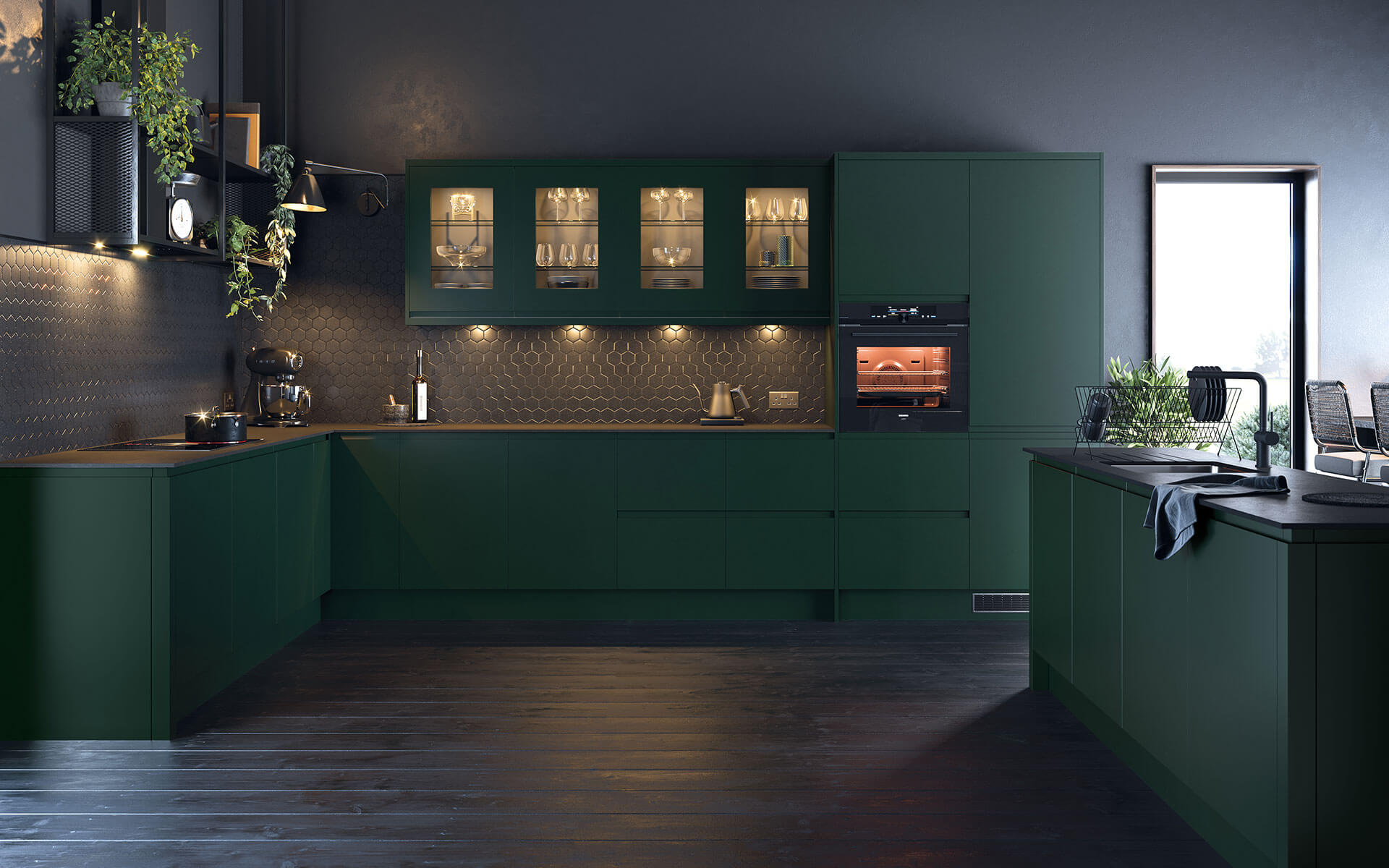
Tailoring Storage to Your Lifestyle:
-
Personalised Solutions: It's important to design your kitchen storage based on your unique needs and tastes. For example, if you love baking, make sure there's a specific area or drawers for your baking gear like trays, bowls, and tools. They should be easy to reach and well-organised. If you enjoy coffee, create a special spot in your kitchen for your coffee equipment, such as the coffee machine, beans, and mugs. This approach to storage makes your kitchen more efficient and adds a personal touch to its design.
-
Integrated Solutions: Including diverse storage options is key in making your kitchen efficient and orderly. You can use custom cabinets made to fit the unique spaces in your kitchen to make full use of all available space. Corner storage options like carousel shelves or pull-out units can also be very useful, as they maximise space that is often overlooked. Organisers designed to fit under the sink can help keep your cleaning products and other essentials neat and easy to find. With careful storage planning, your kitchen can stay tidy and well-organised, with each item having its own dedicated place.
Vertical Space and Hidden Storage:
-
Use Upward Space: Applying the vertical space in your kitchen is an effective approach, particularly handy for small kitchens with restricted floor size. Use high pantry cabinets that reach to the ceiling, giving plenty of storage for various items without using extra floor space. Add open shelves or stacked storage units, offering additional room for dishes, glassware, or pantry items. These also enhance visual appeal and accessibility. By using upward space, you can increase your kitchen's storage ability, resulting in a more tidy and roomy area, even in tight spaces.
-
Hidden Storage Options: When you add extra storage features to your kitchen design, it can make it more practical but still look good. Consider smart solutions like putting in drawers at the bottom of your cabinets. They offer easy access to things that might be hard to reach otherwise. Slide-out racks for food storage are also useful. They let you store and find pantry items quickly and easily. You could also use false cabinet fronts. These hide extra storage compartments and give you more space, without changing the look of your kitchen. These practical choices help you to make the most of storage space. They also help to keep your kitchen looking neat and sleek.
-
Ceiling Storage: Make the most of your kitchen's ceiling space. Adding a hanging rack for your pots and pans not only saves cabinet space but also gives your kitchen a trendy, professional touch. Your cookware becomes a striking design feature of the room.
Designing for Durability and Maintenance
A kitchen is a hub of cooking creativity and regular use, so it's important to choose robust materials and a design that's easy to clean. This will help ensure your kitchen stays attractive and functional for a long time.
Material Selection:
Picking the right materials for your kitchen design is key. You need to find materials that are both durable and easy to maintain, while still looking good. This will help keep your kitchen looking beautiful for years to come.
Choosing Durable Materials:
-
Worktops or Countertops: Worktops are used frequently in kitchen tasks, meaning they need to be made from durable materials. Long-lasting and resistant options include granite, quartz, and solid surfaces. Cheaper but stylish alternatives like butcher block or laminate might need more care.
-
Kitchen Units: When choosing materials for your kitchen cupboards, pick solid, top-grade options that can hold up under frequent kitchen use. Egger Melamine Faced Chipboard (MFC) is a fantastic choice because it's robust and comes in various designs suitable for many kitchen styles. Also, make sure your cabinets' finish can tolerate moisture and heat, especially near the stove or sink. This will help your cabinets keep their looks and sturdiness over time without fading or damage from daily kitchen activities.
-
Flooring: The floor in your kitchen should be strong and simple to clean. Items like porcelain tiles, luxury vinyl, and hardwood are long-lasting and can match many design styles. Also, think about how safe it is to walk on and how comfortable it is.
Ease of Cleaning and Maintenance:
-
Material Finish: Selecting kitchen materials involves both style and practicality. Quartz, for example, is a great pick for countertops. It's not only durable but also low-maintenance, perfect for busy kitchens. Unlike certain natural stones that need frequent sealing and specific care, quartz demands less upkeep. Its surface is non-porous, which means it's resistant to stains and doesn't foster bacteria. This makes quartz an ideal choice where cleanliness and low maintenance are key.
-
Cabinet Surfaces: Cabinets with simple designs are not only good to look at but also easy to clean and maintain. They don't have intricate details or carvings, so dust and grime can't accumulate in hidden corners. Quick and straightforward to clean, these cabinets stay beautiful with little effort. They're a smart choice if you want a kitchen that's both good-looking and practical.
-
Flooring Considerations: In choosing flooring for your kitchen, pick materials that conceal dirt well and are simple to clean. Options that can hide spills and stains will help maintain your kitchen's cleanliness. Textured tiles, while visually appealing and good at hiding dirt, need a bit more effort in cleaning. On the other hand, while smooth floors might show dirt more quickly, they're usually easy and quick to clean, making them a practical choice for busy kitchen areas.
Designing for Easy Maintenance:
Creating a kitchen that's easy to maintain means choosing layouts and materials that make cleaning simpler, so your kitchen stays functional and welcoming without too much work.
Layouts That Simplify Cleaning:
-
Functional Layout: Planning your kitchen layout carefully can greatly improve its cleanliness and usefulness. For instance, having the bin near the food prep area makes it easier to throw away leftovers and prevents messes around the kitchen. This placement makes cooking smoother and helps keep the kitchen clean and hygienic, providing a better overall cooking experience.
-
Easy-to-Reach Design: It's important to ensure everything in your kitchen is easy to reach for cleaning. Try not to install overhead cabinets too high or create deep, hard-to-reach spaces, as they can make cleaning difficult and result in areas being overlooked. Choosing easily accessible storage and appliance placements makes cleaning less of a hassle and aids maintaining hygiene, keeping your kitchen spotless.
Reducing Wear and Tear:
-
Smart Placement of Features: It's important to strategically place materials and items in your kitchen to reduce damage. Try to keep delicate materials or finishes away from areas with a lot of heat or moisture. For example, use tough, heat-resistant materials near the cooker and water-resistant finishes close to the sink to avoid damage and make them last longer. This careful arrangement helps your kitchen stay functional and attractive for longer.
-
Protective Measures: Picking the right kitchen features can really help prolong its quality. Backsplashes are great for keeping your walls safe from food splashes around cooking and sink areas. Also, choosing cabinet surfaces that don't show fingerprints and smudges can make your kitchen look neater. Such smart choices in materials and finishes not only make your kitchen last longer and easier to clean, but also boost its overall look.
Choosing materials and designs that are durable and easy to maintain can keep your kitchen looking fresh and functioning well for a long time. A well-maintained and easy-to-clean kitchen is always a joy to use.
Conclusion
In wrapping up this second section of our kitchen design guide, we've covered vital practical design aspects. This includes taking accurate measurements and selecting long-lasting appliances and materials. Each step is essential in creating a kitchen that's both functional and visually pleasing.
We've explored the balance between good looks and practical use in kitchen design. Every appliance, cabinet, and bit of available space should serve a purpose and enhance your daily routines. Proper ergonomic design is crucial to make your kitchen an enjoyable and productive place to work. Moreover, we've looked at unique storage solutions, designed to suit your kitchen size and specific lifestyle needs.
Keep in mind, a successful kitchen design combines practicality and personal style effortlessly. It's about developing a space that is both functional and comfortable, where every feature has a purpose and adds to the overall balance of the area.
In the next part of our series, we'll concentrate on the final details and personalisation of your kitchen. This includes selecting the right lighting and hardware, and enhancing the space with decorative elements. These finishing touches will transform your kitchen from a simple functional space into the central hub of your home.
Don't miss 'Part 3: How to Design a Kitchen - Finishing Touches and Detailed Designing', where we'll add the final touches that make your kitchen design truly yours.
Read Part 1: How to Design a Kitchen - Planning and Concepts
Ready to take your first steps - Book a FREE Design Consultation today

